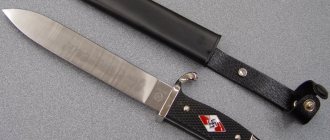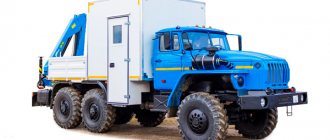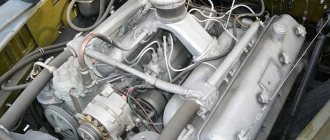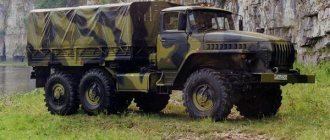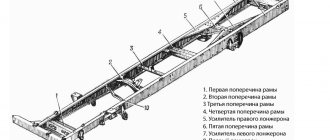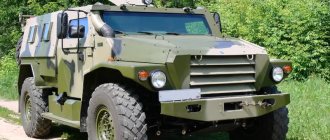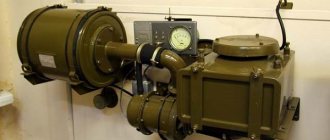Ural 4320 is an all-wheel drive three-axle truck with a 6 by 6 wheel arrangement and increased cross-country ability. The model is manufactured by the Ural Automobile Plant (Miass, Chelyabinsk region). In the manufacturer’s line, the equipment replaced the Ural 375. In many elements, the Ural 4320 is unified with its predecessor, but has improved characteristics and a more modern design. Production of the model started in 1977 and continued until the fall of 2015, after which it was replaced by the Ural Next car. It is noteworthy that export modifications of the Ural 4320 are still produced in small quantities. We are talking about military versions that are purchased by countries in Latin America, Asia and Africa.
Navigation
Story
For a long time, the Ural 375 remained the main product of the Ural Automobile Plant. However, the fuel consumption of the car was enormous - about 50-70 l/100 km. Even for multifunctional military equipment, such an indicator was considered prohibitive, so experts thought about developing a more practical version. The first work in this direction began in the mid-1960s, but the final stage had to wait quite a long time. Serial production of the Ural 4320 started only in November 1977. At the same time, it was decided to abandon the development and implementation of a new diesel engine by Ural specialists; all work was carried out jointly with the Yaroslavl Motor Plant, which at that time was considered the leader in the USSR engine manufacturing segment.
In the 1970-1975s, new transmissions and engines were tested. In 1973, testing of prototype versions began, and in the winter of 1977, preparation of design documentation for large-scale production of equipment began. Despite the appearance of the Ural 4320, the Ural 375 was not abandoned. For several more years it was produced in parallel with its successor.
Initially, the new product was equipped with a KamAZ 740 diesel engine, but after a severe fire at the Kama Automobile Plant in 1993, supplies of the unit ceased. The shortage of diesel engines led to the fact that in 1993-1994 some versions were equipped with ZIL 375 carburetor units. These modifications were practically no different from the Ural 375D, the difference was only in the tail of the engine compartment. Subsequently, YaMZ 236 and YaMZ 238 engines began to be installed in the Ural 4320. Until 2000, models with a more powerful unit had an elongated engine compartment, versions with YaMZ 236 retained the same shape.
In the 1990s, the Ural 4320 acquired a wide bumper with headlights. Plastic plugs were installed at the previous headlight mounting points. Modifications with a narrow bumper were available for the Ministry of Defense. In 1996, production of a two-axle version of the Ural 43206 (4 by 2) with a similar design and lower weight began.
In 2009, the Ural 4320 premiered with an Iveco “P” cabover cab with an interesting rounded hood. The production of this modification in small batches continued until 2014.
With the transition to Euro-4 standard units, the car’s engine range has changed. The previous versions were replaced by YaMZ 536 and YaMZ 6565 motors.
In 2014, the Ural 4320 was modernized. The new model was named Ural-M, but retained the old type of cabin. A year later, an improved version of the Ural Next appeared with an original new generation cabin and improved components.
Kungs, “engineers” and trial trucks: Ural’s rich portfolio
[center]Ural-44201 tractor and Ural-862 active semi-trailer with K-862 van body. Photo: kolesa.ru
What is KUNG?
“Urals” with insulated booths have become one of the most recognizable images in Russian automotive history and modern times. However, there are still different interpretations of the abbreviation KUNG. Let's try to move a little away from the main topic of the cycle and understand the history of this object, the roots of which go back to the post-war period.
"Ural" with KUNG K-4320. Photo: gruzovikpress.ru
At the end of the 40s, the need arose in the USSR for automobile bodies adapted to European railways. As you know, at that time half of Europe was under Soviet control and the issue of safe movement on railway platforms was paramount. The Russian and later Soviet railway network is based on 1520mm gauge, which is wide gauge to the rest of the world. Let us recall that the “Stephenson” gauge of 1435 mm is now more common in the West. The domestic gauge for the 1520 mm gauge is considered 1T in all systems, so there was no necessary designation for the new narrow European gauge. Only zero was suitable. That is why KUNG stands for “universal body of zero dimensions.” But... This is not the only correct definition! The mentioned “Stephenson” European gauge even in pre-war times bore the name of the normal gauge. That is, the second reading of the abbreviation KUNG – “universal body of normal size” – will also be correct.
The first Soviet KUNGs appeared in the Soviet Union after 1953, when the Council of Ministers ordered the paper and woodworking industries to create a special unit specifically for the development and production of new bodies of zero (normal) dimensions. Until 1968, special enterprises created a family of universal bodies: KUNG-1 for ZIS-150 and ZIL-164 vehicles, KUNG-1M for ZIS-151 and ZIL-157, KUNG-1MM for ZIL-131, KUNG-2 for GAZ-63, KUNG-2M - for GAZ-66, KUNG-P6M - for heavy MAZ - 5207V, and finally, KUNG-P10 - for MAZ-5224V. The first manufacturer of the KUNG series was the Shumerlinsky furniture plant, designed to assemble up to 5 thousand universal bodies per year.
Tractor "Ural-44201" and active semi-trailer "Ural-862" with a K-862 van body. Photo: russianarms.ru
If we talk about the history of the Ural-4320 vehicles, then the most common habitable universal body was the K-4320. It was a sealed compartment (an echo of a possible nuclear war), mounted on a special chassis 43203, sheathed on the outside with duralumin or steel, and on the inside with plywood or plastic. The Ural-43203 chassis differed from the basic versions by an elongated frame at the rear overhang, on the end of which a spare wheel was mounted. There were three modifications of vans in total, differing in the location of windows and doors. With a mass of 1460 kilograms, the body allowed loading about 4.5 tons - this was enough for most repair vehicles and mobile headquarters. Later, in the early 1980s, the KM-4320 frame-metal structure appeared, the main advantage of which was the ability to mount heavy equipment on the roof. It was on these bodies that various radio communications, reconnaissance and control equipment was mounted.
The two-axle Ural-43206, which appeared already in the 90s, which was discussed in the previous part of the series, turned out to be an excellent base for transferring universal bodies from the decommissioned ZIL-131 chassis. For example, the P161 radio stations, which previously worked on the chassis of the Moscow Likhachev Automobile Plant, were transferred to these cars.
"Ural-44201" is the basis for active semi-trailers. Photo: koleso.ru
A special place among the habitable bodies of vehicles of the Ural-4320 family is occupied by an active road train consisting of a 44201 truck tractor and a Ural-862A semi-trailer, on which a KM-862 van body was installed. This multi-component design was produced at the Chelyabinsk Machine-Building Plant of Automobile and Tractor Trailers (ChMZAP) in small volumes from 1975 to 1990. The main body of the semi-trailer had an internal length of 9 meters, was equipped with 12 light windows, two FVUA-100N filter ventilation units and two OV-65 heaters. The van was designed at the All-Union Furniture Design and Technological Institute, and assembly was carried out at the Shumerlinsky van plant in Chuvashia. Such vehicles housed, for example, R-362M “Orekh” service radio communication points with a radio relay station and a set of antennas. In addition, the active road train was used as the base of an air-transportable mobile resuscitation and operating complex of modular design. Four of these medical vans formed a single medical post with 22 medical workers and a throughput of 100 people per day.
"Engineers"
Of course, the Ural-4320 series is far from the vehicles of the Kremenchug plant in terms of demand in the engineering troops, but here too, trucks from Miass have firmly taken a place in their weight category.
Tow truck KT-L. Photo: harz110.com
The weight and towing capabilities made it possible to develop light-class tow trucks capable of towing equipment weighing up to 12 tons. This became the KT-L or TK6A-04, produced by the Leningrad automobile repair plant No. 57. The vehicle is practically no different in appearance from a regular flatbed 4320, but a towing device was attached to the rear overhang to the frame, allowing the equipment to be moved using the semi-loading method.
KET-L. Photo: Egor Yavnikov
Next on the list of ranks of rescuers from Miass is KET-L - a lightweight wheeled evacuation tractor, equipped with a one and a half ton boom crane and a traction force of 15 tf. These vehicles are part of evacuation groups and have already fought a lot. In Grozny, during a counter-terrorism operation over the course of three months, a group of one BREM, BTS and two KET-L was able to evacuate 98 units of damaged armored vehicles without losses.
MP-A2.1. Photo: fototruck.ru
MP-A2.1. Photo: russianarms.ru
More modern is the MTP-A2.1 repair and recovery vehicle with a hydraulic manipulator (load capacity up to 4 tons), as well as the ability to transport damaged equipment by semi-loading and towing. MTP-A2.1 is a very versatile engineering machine: it is equipped with a device for starting car engines, containers for transporting fuels and lubricants, a sledgehammer and even a ShTs-11-250-0.05 caliper. By the way, the full name of the chassis for this military tow truck is woven in the best traditions of the domestic automotive industry - “Ural-4320-1060-31”. MTP-A2.1 can be based not only on hooded SUVs from Miass, but also on KamAZ trucks and hooded Urals.
Crane KS-3573. Photo: techstory.ru
Many types of engineering equipment came to the diesel Urals from the previous carburetor 375 series chassis. It was in this way that the KS-2573 military truck crane was slightly modified in the early 80s and installed on the Ural-43202 chassis. Later, the famous “Ivanovets” appeared in the military version KS-3574, capable of lifting up to 12.5 tons with a two-section telescopic boom. The giant from the Motovilikha plant KS-5579.3, capable of lifting up to 22.5 tons, also serves in the army. For such a vehicle it was necessary to provide an extended Ural-4320-30 chassis. Despite the fact that the Ural is inferior in carrying capacity to the KrAZ, it also received the burden in the form of sections of the heavy mechanized bridge TMM-3. Moreover, there is an option to install bridge spans on biaxial semi-trailers of the Ural-44202 truck tractor.
The glorious past of the domestic truck trial
If KamAZ’s sporting pride, for which the entire automobile plant works, is the KamAZ-Master team, which became the world leader among camions in rally raids, then UralAZ at one time also had its own sports icon. This is a truck trial, or racing on four-wheel drive trucks over very rough terrain. The main task of the crew in this competition is not just to go through all the stages, leaving all the limiters on the track intact, but also to meet the allotted time. Stopping for more than 3 seconds, restarting the engine, or driving off the road are punishable by penalty points. The first such competitions were organized in France thirty years ago in the town of Steinburg. Before this, trials were done on bicycles, motorcycles, and jeeps, but they were able to think of releasing them into ravines and mud baths only in 1990 in Europe.
"Urals" at a truck trial. Photo: carakoom.com
Since then, spectacular competitions have been held in the Old World at various intervals, collecting dozens of thoroughly redesigned all-wheel drive trucks. What does the military theme have to do with it, you ask? The thing is that in 1996, the truck trial came to Russia, and one of the ideological inspirers and organizers was the 21st Research Institute of the GABTU of the RF Ministry of Defense. In fact, the competitions were initially held at the institute’s training ground in Bronnitsy, near Moscow. In 1996, 17 cars were launched, thoroughly modified in factory workshops or simply by the hands of enthusiasts. There were prototypes - for example, GAZ-3937 and ZIL-390610, as well as 6x6 group vehicles from the ZIL, Ural, KamAZ and MAZ army families. The 4x4 group was represented by GAZ-66, Sadko and KamAZ-4326. Crews of the Russian Armed Forces from the Ryazan Automobile Institute and the 21st Scientific Research Institute took part in the competition - this turned out to be an excellent school for both professional military drivers and army test engineers. The format of the article does not allow us to tell the long and thorny history of the domestic truck trial, so we will focus only on the successes of Ural cars in this difficult sport.
Work at the plant in this direction has been carried out in the Experimental Research Production of the Scientific and Technical Center since 1990. The main workhorse in the truck trial was the two-axle Ural-43206 with an uprated YaMZ-236BE with a power of 250 hp. But the heavy Ural-53232 also competed in the 8x8 class. Six-wheel all-wheel drive vehicles were represented by the cabover Ural-6361.
Modern "Urals" in the tark trial have no relation to the plant in Miass. Photo: autoreview.ru
Over the years of the existence of the domestic truck trial, the team from Miass has become the most titled. KamAZ, despite its much greater financial capabilities, was unable to achieve clear success in these competitions. To the credit of the Ural factory workers, it should be noted that most of the machine components for the truck trial were produced in Russia. At least in the first few years. Now count how much original KAMAZ is in the famous raid vehicles from Naberezhnye Chelny. “Urals” competed on equal terms in Europe (and often won!) with such world leaders in the automotive industry as MAN and Mercedes. At the same time, sports trucks from the Urals traveled under their own power to the Europa Truck-Trial competitions in Germany, Austria, Italy and France. As a result, from the truck trial in the late 90s - early 2000s, the Urals never returned without prizes, and in 2002 in Europe they won 1st and 2nd places, and at the Commonwealth Championships of Russia and Belarus they received two first, two second and one third place. And now, in European truck-trial rides, the “Urals” are not the last violins to play. True, the drivers are no longer from Russia, and the cars have nothing to do with the Miass factory teams.
To be continued…
Purpose
The main purpose of the Ural 4320 is to transport people and cargo, tow various equipment and trailers on roads of any type and on rough terrain. Thanks to the 6 by 6 wheel design, impressive ground clearance and powerful unit, the car confidently overcomes swampy areas and has enormous off-road potential.
The Ural 4320 chassis is used as a base for assembling curtain-sided and flatbed trucks with different wheelbase lengths. Pipe carriers, crew buses with 22 or 30 seats, special vehicles for gas and oil production, fuel tankers, tank trucks, municipal and road equipment, military vehicles and fire engines have also been created based on the model.
Ural 4320, equipped with a hydraulic manipulator, allows you to unload and load timber and assortments without the use of special equipment. The unique design allows for efficient operation of equipment in areas with temperatures from -50 to +50 degrees (all the way from the southern deserts to the Far North). The equipment itself is characterized by a huge margin of safety, simplicity of design and high maintainability.
Nomenclature of transfer cases installed on Ural vehicles.
Transfer cases with a top gear ratio I in = 1.21 are installed on Ural vehicles (the ratio of the number of teeth of the driven gear Z 1
=26 (on the intermediate shaft) to the number of teeth of the drive gear Z
2
=28 (on the input shaft).
Transfer cases with a gear ratio of the highest pair I in = 1.3 ( Z 2
/ Z
1
=27/27) were installed until May 2002. and kept for supply to spare parts.
The gear ratios of the speedometer drive gears (the ratio of the number of teeth of the driven gear (in the cover) to the number of gear teeth (on the intermediate shaft) are given in Table 7.
Using this table, it is recommended to determine the transfer case part number depending on the tire size, gear ratio and transfer case.
Only a transfer case with the corresponding part number should be installed on the vehicle.
If the transfer case does not match the car model, the manufacturer is not responsible for the performance of the car and the speedometer readings.
| Tire | Gearbox (I r) | Speedometer drive (I sp) | Transfer case designation | |
| 1 | 2 | 3 | 4 | 5 |
| I n = 1.21 | I in = 1.3 | |||
| OI-25 | 8,9 | 4,8 | 4320Х- 1800012 4320Х- 1800018 4320Х- 1800020 | 5557-1800012 5557-1800018-01 5557-1800020-01 |
| 8,05 | 4,4 | 43202-1800012-10 43202-1800018 43202- 1800020- 10 w/h | ||
| 7,32 | 4 | 4320-1800012-20 4320-1800018-10 4320-1800020-20 s/h | 4320- 1800012-10 4320-1800018 4320-1800020-10 s/h | |
| 6,69 | 3,69 | 4320Я-1800020-20 4320Я-1800018 4320Я-1800020 с/ч | ||
| ID-P284 | 8,9 | 5,33 | 44202-1800012 44202-1800018 44202-1800020 | |
| 8,05 | 4,8 | 4320Х- 1800012 4320Х- 1800018 4320Х- 1800020 с/ч | 5557-1800012 5557-1800018-01 5557-1800020-01 s/h | |
| 7,32 | 4,4 | 55571-1800012-10 55571-1800018-10 5557 1-1800020-10 s/h s/h | 43202-1800012-10 43202-1800018 43202-1800020- 10 w/h | |
| 6,69 | 4 | 4320-1800012-20 4320-1800018-10 4320- 1800020-20 s/h | ||
Note:
The transfer case designation carries the following information:
- 4320-18000 12
-20 Transfer case with HOUSE; - 4320-18000 18
-10 Transfer case with brake; - 4320-18000 20
-20 Transfer case without HOUSE and brake (in spare part).
List of design features of frames:
Best in cross-country ability – from the Far North to the “Far South”
2005 year. A catastrophic, unprecedented flood in the southern states of the United States. In particular, in the city of New Orleans. The rescue operation on the flooded streets of the largest metropolis in Louisiana is carried out using Ural-4320 trucks from the Mexican army. Cars from Miass passed through all the complex intricacies of narrow, flood-ridden streets of black neighborhoods - where American military trucks were powerless. And this is just one of many episodes of the combat work of the Ural-4320, in which these powerful vehicles clearly demonstrated their capabilities. A detailed review of this model is in this publication.
“Ural-4320” is a three-axle all-wheel drive (6x6 formula) off-road truck from the Ural Automobile Plant (city of Miass, Chelyabinsk region). In the company's model range back in 1977, it replaced the Ural-375 truck.
In a number of design elements, the Ural-4320 vehicle is unified with the previous model, the Ural-375. However, it has a more modern design, which provides expanded capabilities and better operational and technical characteristics than the Ural-375. The 4320 was the main model of the Ural Automobile Plant until the fall of 2015 (before its official replacement with the Ural Next.
The Mexican Marina Armada during the rescue operation in Louisiana after Hurricane Katrina in 2005.
But its production for export needs is still ongoing. Since the Ural-4320 is still in demand as a military vehicle in many countries in Asia, Africa and Latin America. There, to this day, he continues to evoke genuine respect and real admiration with his charisma. And the price is quite affordable!
Modifications
- Ural 4320 – chassis with a classic metal cabin and a load capacity of 7-9 tons;
- Ural 4320-19 – version with an extended base and a load capacity of 12 tons;
- Ural 43203 – chassis with reinforced suspension in the front;
- Ural 43204 – chassis with increased load capacity for a pipe hauling tractor;
- Ural 44202 is a truck tractor based on the Ural 4320, designed to work with a semi-trailer on any type of road;
- Ural 43206 is a lightweight version of the chassis with a 4 by 4 wheel arrangement.
Options for the tail and cockpit (Ural 4320):
- 40/41 – 3-seater all-metal 2-door cab (versions with a 4-door double cab have a similar index);
- 42/44 – 3-seater all-metal 2-door cabin with a berth;
- 48/58/59 – a more spacious and comfortable cabin with a sprung driver’s seat and plastic tail;
- 70/71/72/73/74/75 – Gazelle Next cabin module in 3- or 7-seat version.
Special IVECO cabover cabs are also available.
Army modifications:
- Ural 4320-09-31 - armored vehicles based on the Ural 4320-31 with armored glass, reinforced safe doors with locks with internal locking, a cabin made of armored sheets and firing embrasures. The roof, rear wall and floor are made of armored sheet. The cabin is designed for 2 people. The space vacated by the 3rd seat was used for installing chemical or radiation reconnaissance devices, radio stations and night vision devices. The fuel tank, hood and radiator “mask” are also armored. Optionally, a body with an armored module for 15-20 people is installed;
- Ural 4320-0010-31 (Ural E4320D-31) is an armored model of the “Motovoz-1” series with an armored module, designed for transporting goods, people and towing trailer systems. The equipment is manufactured on the basis of Ural 4320-31 (6 by 6). The car has increased protection against weapons and mines. The debut of Ural 4320-0010-31 took place in Bronnitsy at an exhibition of military equipment.
Specifications
Dimensions:
- length – 7588 mm;
- width – 2500 mm;
- height – 2785 mm;
- wheelbase – 3525 (+1400) mm;
- ground clearance - 400 mm;
- front track – 2000 mm;
- rear track – 2000 mm;
- turning radius (outer wheel/overall) – 10800/11400 mm.
The curb weight of the car varies from 8000 to 8700 kg. The standard version has a load capacity of 7000 kg. Total weight – 15205 kg. For the basic version, the load on the front axle is 4550 kg, on the rear axle – 3550 kg. Load distribution at full weight: front axle – 4635 kg, rear axle – 10570 kg.
Versions with a shortened length (7388 mm) and increased load capacity (10000 kg) are also available. The extended variation Ural 4320 has a length of 8980 mm, a wheelbase of 4555 mm. The carrying capacity of this modification is 12,000 kg, curb weight is 8,740 kg.
The standard body has the following dimensions:
- length – 5685 mm;
- width – 2330 mm;
- height – 1000 mm.
Other characteristics:
- ford depth – 1600 mm;
- depth of surmountable ditches and ditches – up to 2000 mm;
- maximum lift – 60%;
- Fuel tank capacity – 300 l with the possibility of installing an additional tank of 60 l.
The history of the creation of the basic car chassis
Since the early sixties of the 20th century, the Ural plant began to produce a truck of its own design - the Ural-375.
With all the positive qualities in cross-country ability, which was very important at that time, this car had a serious drawback: a gasoline engine that consumed a huge amount of high-quality fuel - 50-60 liters per 100 km.
In 1977, it was replaced by the Ural-4320.
It was originally planned in several modifications and was intended for the transport of various goods and people, as well as for the transport of trailers and trailers.
Due to the fact that at its base it was designed as an all-wheel drive vehicle with three drive axles, the Ural-4320 easily traversed difficult roads and swampy areas, and was also capable of fording up to one and a half meters deep.
This was facilitated by the sealing of all main components of the engine and machine during manufacturing and assembly.
The filling capacities of truck fuel tanks allow you to take on board up to 300 liters of diesel, and in some modifications – up to an additional 60 liters.
Further changes in the technical characteristics of this tractor made it possible to create a vehicle that was capable of driving off-road, regardless of the condition of the ground.
Do you know why the Tatra-148 truck is still in demand today? This article describes what types of vans the Hyundai Porter can be equipped with.
Military applications
Thanks to its unique characteristics, the Ural-4320 was very popular in the USSR Armed Forces.
During the fighting in Afghanistan, another quality of this vehicle was revealed. When a mine exploded, the personnel in the back did not receive injuries or concussions. The explosion of an armored personnel carrier guaranteed one hundred percent concussion.
The basic serial Ural-4320 was produced from 1977 to 1986. It was replaced by the Ural-4320-01 with a new on-board platform, which was produced until 1993.
Engine
The Ural 4320 was equipped with various types of power plants:
- KamAZ-740;
- YaMZ-236;
- YaMZ-238;
- YaMZ-6565;
- YaMZ-536.
KamAZ-740 has long been considered the basic unit of the series. The V-shaped “eight” provided excellent traction and was highly reliable. The engine design had much in common with the products of the Yaroslavl Motor Plant, but there were a number of obvious differences. Thus, each KamAZ-740 cylinder was equipped with a separate block head.
Characteristics of the KamAZ-740 engine:
- working volume – 10.86 l;
- rated speed – 2600 rpm;
- rated power – 154 (210) kW (hp);
- maximum torque – 650 Nm;
- compression ratio – 17.
Diesels YaMZ-236 and YaMZ-238 replaced the KamAZ-740 engine after a fire at the Kama Automobile Plant. Structurally, the engines had much in common, but the main difference was the number of cylinders.
YaMZ-236 was considered the founder of a series of V-shaped engines from the Yaroslavl plant. The unit was produced in Euro-1 and Euro-2 versions. The 4-stroke engine had direct fuel injection and a water cooling system.
Characteristics of the YaMZ-236 engine:
- working volume – 11.15 l;
- rated speed – 2100 rpm;
- rated power – 169 (230) kW (hp);
- maximum torque – 882 Nm;
- number of cylinders – 6;
- compression ratio – 16.5.
The YaMZ 238 diesel engine was installed on more powerful versions. It was characterized by compression ignition, liquid cooling and direct injection (available in turbocharged and non-turbocharged versions).
Unit characteristics:
- working volume – 14.86 l;
- rated speed – 2100 rpm;
- rated power – 176 (240) kW (hp);
- maximum torque – 883 Nm;
- number of cylinders – 8;
- compression ratio – 16.5.
The YaMZ-6565 and YaMZ 536 motors were included in the engine line due to stricter environmental standards.
The YaMZ-6565 unit is part of the family of V-shaped 6-cylinder diesel engines of the Yaroslavl plant. The engine has a turbocharger, a liquid-oil heat exchanger, intermediate air cooling, water cooling and direct fuel injection. The engine complies with the Euro-4 environmental class.
Characteristics of the YaMZ-6565 unit:
- working volume – 11.15 l;
- rated speed – 1900 rpm;
- rated power - 220.6 (300) kW (hp);
- maximum torque – 1275 Nm;
- compression ratio - 17.5.
The YaMZ-536 engine belongs to the 530th family of engines and is a basic “six” with an in-line cylinder arrangement, a turbine and liquid cooling. To ensure Euro 4 compliance, the unit uses a catalytic converter and an exhaust gas recirculation (EGR) system.
Characteristics of the YaMZ-536 engine:
- working volume – 6.65 l;
- rated speed – 2300 rpm;
- rated power – 229 (312) kW (hp);
- maximum torque – 1226 Nm;
- service life – 1,000,000 km.
Onboard Ural-4320-0110-41 - URAL-4320
The flatbed cargo vehicle URAL 4320-0110-41 is designed for transporting various goods, people, and towing trailers on all types of roads and terrain.
* Tire pressure regulation system - centralized with control from the driver's seat; provides control of air pressure in tires, changes in air pressure in tires when overcoming areas of terrain with low bearing capacity, the ability to drive with minor damage to tires.
| Flatbed Ural-4320-0110-41: load capacity 6000 kg, total trailer weight - no more than 11500 kg; internal platform dimensions: length 3890 mm, width 2330 mm, height 1000 mm; engine: YaMZ-236NE2 diesel V6, with turbocharger and intercooling, Euro 2, power 169 kW (230 hp) at 2100 rpm. | ||
| Wheel formula | 6×6 | |
| Total weight, kg | 14900 | |
| Distribution of the total weight of the onboard vehicle, kg | to the front axle | 4925 |
| on the rear trolley | 9975 | |
| Weight of transported cargo, kg | 6000 | |
| Total weight of the towed trailer, kg | 11500 | |
| Maximum speed, km/h | 82 | |
| Engine | YaMZ-236NE2 diesel V6, with turbocharger and intercooling, Euro 2 | |
| Rated engine power, kW (hp) | 169 (230) at 2100 min-1 | |
| Maximum torque, Nm (kgfm) | 883 (90) at 1350 min-1 | |
| Clutch | double-disc with pneumatic amplifier | |
| Transmission | mechanical, five-speed, three-way | |
| Transfer case | mechanical, two-stage with lockable center differential | |
| Drive axles | through-type with overhead final drive | |
| Cardan transmission | open type with hinges on needle bearings | |
| Front suspension | on two semi-elliptic springs with hydraulic telescopic shock absorbers | |
| Rear suspension | balancing with reaction rods | |
| Onboard platform | metal with a rear folding side, equipped with removable arches and an awning, side folding and removable benches | |
| Internal dimensions of the platform, mm | length | 3890 |
| width | 2330 | |
| height | 1000 | |
| Number of seats for transporting people | 27 | |
| Cabin | all-metal, three-seater, equipped with a ventilation system | |
| Steering | with double-acting hydraulic booster | |
| Service brake system | with pneumohydraulic double-circuit drive | |
| Auxiliary braking system | motor-type retarder, compression | |
| Tires | 14.00-20 146G OI-25 with adjustable pressure* | |
| Rated voltage of electrical equipment, V | 24 | |
| Number of batteries, pcs. | 2 | |
| Battery capacity, Ah | 2 x 190 | |
| Fuel tank capacity, l | 300 + 60 | |
| Control fuel consumption at a speed of 60 km/h, l/100 km | 35 | |
| Cruising range based on control fuel consumption at a speed of 60 km/h, km | 980 | |
| Ground clearance, mm | 400 | |
| Overall dimensions of the car Ural 4320-0110-41, mm | length | 7630 |
| width | 2500 | |
| height | 3005 | |
| External overall turning radius along the buffer, m | 11,4 | |
| Overcoming obstacles, ‰ (%) | climb | 600 (60) |
| Lifetime before first major overhaul, km | 250000 | |
xn—4320-3ve1ftb0a.xn--p1ai
Device
Chassis
The Ural 4320 has high cross-country ability, which was achieved due to the 6 by 6 wheel arrangement and single-pitch wheels, supplemented by automatic adjustment of filling the chambers with air. The front part uses a dependent suspension mounted on semi-elliptical springs with sliding rear ends and double-acting shock absorbers. The rear part also uses a dependent balancer suspension with springs with reaction bars. All axles of the car are driving.
Base wheel parameters:
- type – disk with fastening on 10 studs;
- rim - 330-533 or 254G-508;
- tire type – tube pneumatic.
The riveted frame of the Ural 4320 consists of 2 stamped spars, united by cross members (ladder type).
Onboard Ural-4320-0611-31 — Main page Ural-4320
The URAL 4320-0611-31 flatbed general transport cargo vehicle is designed for transporting various cargoes and towing trailers on all types of roads and certain areas of terrain (snowy, sandy, swampy, etc.).
* Tire pressure regulation system - centralized with control from the driver's seat; provides control of air pressure in tires, changes in air pressure in tires when overcoming areas of terrain with low bearing capacity, the ability to drive with minor damage to tires.
The car is equipped with spare parts.
At the customer's request, the vehicle can be equipped with:
| Flatbed Ural-4320-0611-31: load capacity 7000 kg, total trailer weight - no more than 11500 kg; internal platform dimensions: length 4500 mm, width 2326 mm, height 715 mm; engine: YaMZ-238M2 diesel, power 176 kW (240 hp) at 2100 rpm. | ||
| Wheel formula | 6×6 | |
| Total weight, kg | 15865 | |
| Distribution of the total weight of the onboard vehicle, kg | to the front axle | 4900 |
| on the rear trolley | 10965 | |
| Weight of transported cargo, kg | 7000 | |
| Total weight of the towed trailer, kg | 11500 | |
| Maximum speed, km/h | 82 | |
| Engine | YaMZ-238M2 diesel | |
| Rated engine power, kW (hp) | 176 (240) at 2100 min-1 | |
| Maximum torque, Nm (kgfm) | 883 (90) at 1350 min-1 | |
| Clutch | double-disc with pneumatic amplifier | |
| Transmission | mechanical, five-speed, three-way | |
| Transfer case | mechanical, two-stage with lockable center differential | |
| Drive axles | through-type with overhead final drive | |
| Cardan transmission | open type with hinges on needle bearings | |
| Front suspension | on two semi-elliptic springs with hydraulic telescopic shock absorbers | |
| Rear suspension | balancing with reaction rods | |
| Platform | wooden with three folding sides, equipped with removable extension sides and an awning cloth | |
| Internal dimensions of the platform, mm | length | 4500 |
| width | 2326 | |
| height | 715 | |
| Cabin | all-metal, three-seater, equipped with a ventilation system | |
| Steering | with double-acting hydraulic booster | |
| Service brake system | with pneumohydraulic double-circuit drive | |
| Auxiliary braking system | motor-type retarder, compression | |
| Tires | 14.00-20 146G OI-25 with adjustable pressure* | |
| Rated voltage of electrical equipment, V | 24 | |
| Number of batteries, pcs. | 2 | |
| Battery capacity, Ah | 2 x 190 | |
| Fuel tank capacity, l | 300 | |
| Control fuel consumption at a speed of 60 km/h, l/100 km | 38 | |
| Cruising range based on control fuel consumption at a speed of 60 km/h, km | 750 | |
| Ground clearance, mm | 400 | |
| Overall dimensions of the car Ural 4320-0611-31, mm | length | 7865 |
| width | 2500 | |
| height | 2785 | |
| External overall turning radius along the buffer, m | 11,4 | |
| Overcoming obstacles, ‰ (%) | climb | 600 (60) |
| Lifetime before first major overhaul, km | 200000 | |
xn—4320-3ve1ftb0a.xn--p1ai
Transmission
The basic version of the Ural 4320 was equipped with a KamAZ 141 5-speed manual transmission with synchronizers in all gears, with the exception of first and reverse. Together with the gearbox, a KamAZ 14 double-disc clutch with a pneumatic booster and a mechanical release drive or a YaMZ 182 dry single-plate friction-type clutch with a diaphragm spring was used. The transmission included a transfer case. Some versions were equipped with a 5-speed manual transmission YaMZ 236U with synchronizers at 2,3,4 and 5 speeds.
The two-speed transfer case had a locking planetary-type center differential. The torque distribution between the front axle (always on) and the bogie axles was 1:2. The transfer case was controlled using 2 levers, the level of power take-off from the engine was 40%.
URAL 4320
| Equipment | |
| Availability | 6x6, YaMZ 236NE2, 230 hp, rotational chassis, ABS |
| Main characteristics | |
| Wheel formula | 6×6 |
| Weight of the equipped chassis, kg | 8 265 |
| Gross vehicle weight, kg | 17 300 |
| External overall turning radius along the buffer, m | 11,6 |
| Overall dimensions of the car, mm | 7588x2500x2785 |
| Maximum speed, km/h | 85 |
| Fuel tank capacity, l | 300 |
| Weight of placed and transported cargo, kg | 6 855 |
| Total weight of the towed trailer (semi-trailer), kg | 11 500 |
| Ground clearance, mm | 360 |
| Engine | |
| Model/Type | YaMZ-236NE2 diesel, four-stroke, six-cylinder, with direct fuel injection, V-shaped, meets the Euro-3 standard. Equipped with a pre-heater. |
| Working volume, l. | 11,15 |
| Rated power at 2100 1/min, kW (hp) | 169 (230) |
| Maximum torque at 1100-1300 min-1, N.mkgf/m | 882 (90) |
| Transmission | |
| Steering | With built-in double-acting hydraulic booster |
| Clutch | , friction, dry, single-disk, diaphragm, with pull-type diaphragm spring |
| Transmission | YaMZ-236U, mechanical, three-way, five-speed with synchronizers in 2, 3, 4, 5 gears |
| Transfer case | Mechanical, two-stage with lockable center differential |
| Cardan transmission | Open, four shafts, with hinges on needle bearings |
| Drive axles | Pass-through type with overhead final drive |
| Suspension | |
| Front | On two semi-elliptic springs with hydraulic telescopic shock absorbers |
| Rear | Balanced with reaction rods |
| Electrical equipment | |
| Electrical system | Single-wire, rated voltage 24V |
| Accumulator battery | 2 pcs., capacity 190 Ah each |
| Generator | AC, power 1000 W, works in conjunction with a non-contact voltage regulator |
| Starter | Electromagnetic switching, maximum power 8.2 kW |
| Cabin | |
| Cabin type | All-metal, three-seater, two-door, equipped with increased thermal and noise insulation, ventilation and heating system, adjustable driver's seat |
| Frame | |
| Type | Riveted, consists of two stamped spars connected to each other by cross members |
| Brake system | |
| Service brake system | Drum type with pneumohydraulic drive |
| Auxiliary braking system | Motor-type retarder, compression, installed in the exhaust system |
| Parking brake system | Drum-type brake mechanism installed on the output shaft of the transfer case |
| Wheels | |
| Type | Disk |
| Tires | 1200x500x508 156F ID-284, 425/85 R21 KAMA-1260, KAMA-1260-1, 390/95 R20 KAMA-Ural, 14.00-20 OI-25 with adjustable pressure |
| Load distribution of vehicle gross weight | |
| To the front axle | 5 300 |
| On the rear trolley | 12 000 |
| Load distribution of a loaded vehicle | |
| - to the front axle | 4 685 |
| - on the rear trolley | 3 580 |
kung.ru
Cabin
The Ural 4320 was equipped with various types of metal cabins. The classic version used a 2-door, 3-seater version. The first cabin samples for the model were developed in the middle of the last century; since then, changes inside have been minimal, so in terms of comfort the car is much inferior to modern modifications.
The driver's seat has several settings to select the optimal position. The cabin has heating and ventilation systems to maintain a normal microclimate. Optionally, the cabin is equipped with a berth. Upon request, installation of air conditioning, Webasto preheater and independent heater is available.
Since the spring of 2009, certain versions of the Ural 4320 have been equipped with new-style cabins, created jointly with Iveco. The cabover version with fiberglass tail is equipped with 3 anatomical seats with headrests and armrests. The interior decoration is made of high-quality materials with good heat and sound insulation. The controls are located next to the driver. The new cabin is significantly ahead of the previous version in terms of comfort, but in terms of charisma it is clearly inferior to it.
The body of the Ural 4320 is made in the format of a metal platform with a tailgate. It is equipped with benches, removable arches, an awning and additional sides. To increase cross-country ability, the structure is made in the form of small overhangs.
How much does a gazelle booth weigh?
The half-hood cab is rigidly fixed to the frame through brackets with rubber cushions on spacer bushings. length 3,100 mm, width 2,100 mm, height 380 mm; weight
280 kg.
Interesting materials:
How to recover deleted from deleted photos on iPhone? How to recover deleted messages in Messages on iPhone? How to recover deleted Viber messages on iPhone? How to recover deleted iPhone phones? How to recover deleted iPhone videos? How to recover a deleted conversation in WhatsApp on iPhone? How to recover a deleted shortcut on iPhone? How to recover a deleted contact on iPhone? How to recover deleted text on iPhone? How to recover deleted text in a note on iPhone?

